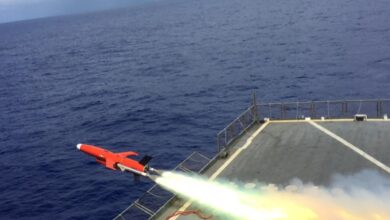USAF Tests Angry Kitten Electronic Warfare Pod on MQ-9 Reaper
The US Air Force recently tested the Angry Kitten ALQ-167 Electronic Countermeasures (ECM) Pod on an MQ-9A Reaper drone.
The pod-equipped MQ-9A demonstrated its enhanced capability against ground and airborne threats in the first round of ground and flight trials on April 10.
“Electronic Attack on the MQ-9 is a compelling capability,” 556th Test and Evaluation Squadron (TES) commander Lt. Col. Michael Chmielewski said.
“15 hours of persistent noise integrated with a large force package will affect an adversary, require them to take some form of scalable action to honor it, and gets at the heart of strategic deterrence.”
Angry Kitten ECM Pod
The Georgia Tech Research Institute-developed ECM pod enhances the Reaper’s survivability and “complicates adversary planning efforts,” the 556th TES explained.
The machine-learning software-equipped pod picks the best “optimal jamming technique from available options” and self-corrects if required.
The pod is currently deployed with some US Air Force adversary air squadrons and was tested with an F-16 in 2021 to assess its compatibility with aircraft systems such as Fire Control Radar.

Cold Integrated Combat Turn
Meanwhile, the squadron also executed a Cold Integrated Combat Turn on an MQ-9 in early April, including simultaneous refueling and rearming of four Hellfire missiles.
The exercise took only 25 minutes compared to the standard three-hour turn time for the MQ-9.
“The Cold Integrated Combat Turn furthers our validation efforts on the MQ-9 agile combat employment model and further maximizes the MQ-9’s relevancy across the continuum of strategic competition and the phases of combat operations in all theaters that require agile operations,” Chmielewski said.












